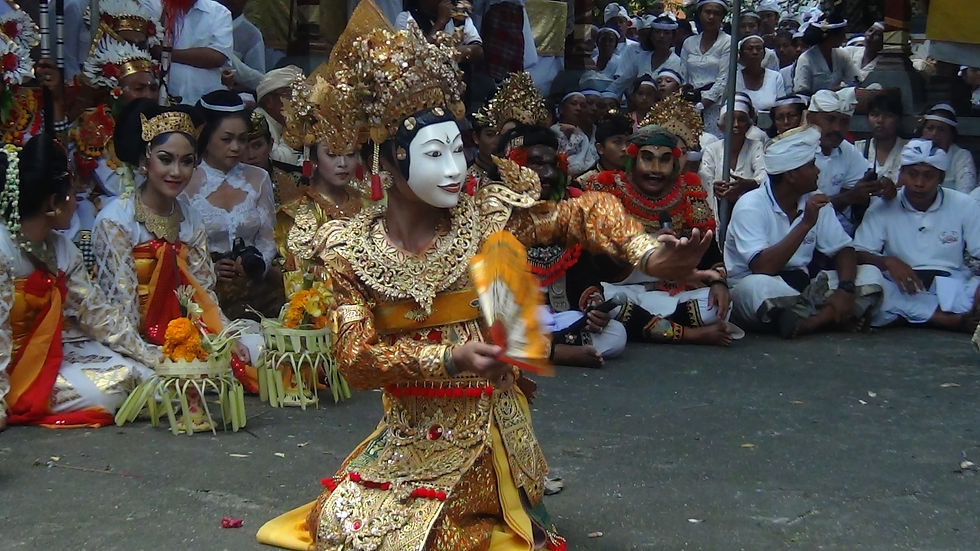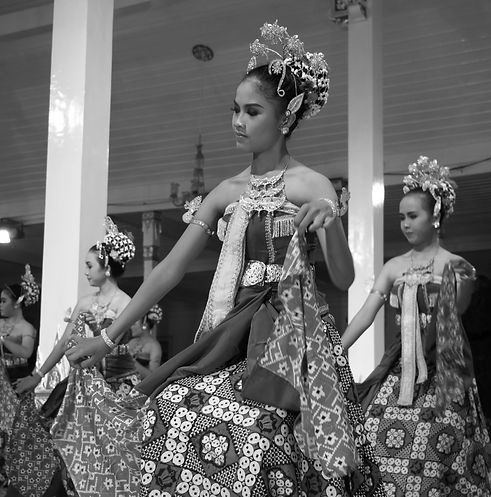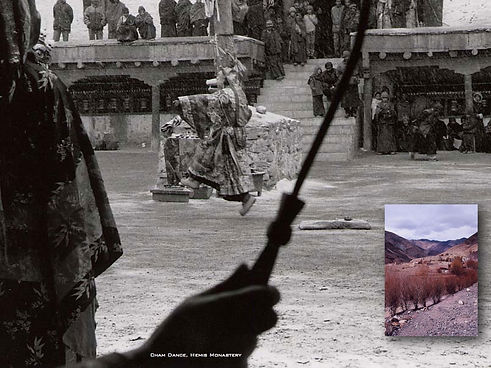
Talented Putu a young dancer from Balerung performing the sacred Legong Dewa Sri Sedana dance at Pura Puseh in Peliatan, circa 2014
Tarian Bedhaya : A Dance of Deep Spirituality
In the realm of classical dance, Bedhaya holds a special place, not only for its aesthetic beauty and rich cultural heritage but also for its profound educational significance. Originating from the Surakarta palace, Bedhaya is a cherished art form that provides the audience a captivating glimpse into the values of tradition, spirituality, and history.
The Aesthetic Principle
The aesthetic principles of Bedhaya revolve around unspoken beauty and strength. Each movement is meticulously crafted, embodying grace and fluidity that captivate the audience. The dancers portray a romance that transcends time, specifically the relationship between Ratu Kidul (Queen of the Southern Sea) and Raja Mataram (the king), brought to life through delicate hand gestures and movements that engage the entire body. This dynamic interaction between the dancers conveys not just a story but an emotional journey that resonates deeply with viewers.
Cultural Significance, Costume and the Gamelan
Bedhaya is not merely about the dance but also about the rich symbolism embedded in the attire. Dancers traditionally wear a tie sarong, a velvet blouse, and a gold scarf, each garment chosen for its cultural significance and aesthetic appeal. The costumes enhance the performance, reflecting the elegance and sophistication of Javanese culture. A hallmark of Bedhaya is its enchanting musical accompaniment provided by Gamelan instruments. The intricate compositions of the Gamelan create an immersive atmosphere that sets the mood for the dance, enhancing the emotional depth and spiritual experience for both performers and spectators.


Tarian Enggang - Hornbill Dance of the Dayak Kenyah
The Enggang Dance is a vibrant expression of the cultural heritage of the Dayak Kenyah tribe in East Kalimantan, Indonesia. As an essential aspect of their identity, this traditional dance holds a pivotal role in every ceremonial gathering, serving as a beautiful portrayal of the daily life of the hornbill bird, a revered symbol in Dayak Kenyah belief systems.
The Spiritual Connection to the Hornbill
According to the beliefs of the Dayak Kenyah people, their ancestors are said to have descended from the sky, much like the hornbill bird. This connection fosters a deep respect and veneration for the hornbill, which is celebrated through the Enggang Dance. The dance not only reflects the culture’s appreciation of nature but also reinforces the significance of their ancestral stories, making it a vital practice within their community.
Typically performed by young girls of the Dayak Kenyah tribe, the Enggang Dance is characterized by its stunning presentation. The dancers adorn themselves with captivating ornaments, including hornbill headpieces and large earrings. They also gracefully hold the feathers of the hornbill, enhancing the dance's visual appeal and connecting the performance to the bird’s characteristics. The Enggang Dance is brought to life through the accompaniment of traditional music, featuring instruments such as the Sape, Gendang, and Gong. The Sape, a distinctive Dayak string instrument, adds a melodic richness that complements the dance's movements, creating an immersive cultural experience.
https://youtu.be/pjImtafUQUk
* Nganjat: The principal movement, which emulates the elegant and unique posture of the ivory hornbill. This motion symbolizes beauty and fluidity, allowing dancers to express themselves through delicate yet powerful gestures.
* Ngasai: This movement involves dynamic motions that convey the vibrant energy of the hornbill and its environment.
* Purak Barik: Serving to reflect the connection between the dancers and the natural world, this movement incorporates traditional storytelling through physical expression.
Peking Opera
Peking opera is a form of performance art that combines singing, reciting, acting, and martial arts. Although it is widely practised across China, its main centres of performance are Beijing, Tianjin, and Shanghai. Peking opera is primarily sung and recited in the Beijing dialect, and its librettos are composed according to a strict set of rules that emphasise form and rhyme. These works tell stories about history, politics, society, and daily life, aiming to both entertain and inform.
The music of Peking opera plays a crucial role in setting the pace of the performance, creating specific atmospheres, shaping characters, and guiding the narrative. ‘Civilian plays’ focus on string and wind instruments, such as the high-pitched jinghu and the dizi flute, while ‘military plays’ feature percussion instruments like the bangu or daluo. The performance is characterised by a symbolic, formulaic style, with actors and actresses adhering to established choreography for movements of the hands, eyes, torso, and feet. Traditionally, stage settings and props are kept to a minimum. Costumes are elaborate, and the exaggerated facial make-up uses a set of concise symbols, colours, and patterns to represent characters' personalities and social roles.


The Cham Dance
The Cham dance (Tibetan: འཆམ་) is a vibrant, masked and costumed dance associated with Vajrayana Buddhism. The dance is accompanied by music played by monks using traditional Tibetan instruments. These dances often convey moral lessons related to karunā (compassion) for sentient beings and are believed to bring merit to all who witness them. Chams are regarded as a form of meditation and an offering to the gods. The leader of the cham is typically a musician who keeps time with a percussion instrument, such as cymbals, with the one exception being Dramyin Cham, where the timing is kept using the dramyin. The term "devil dance" was coined in the early 20th century, reflecting Western perceptions of the costumes worn by the performers.
Chams often depict scenes from the Jatakas of the sage Padmasambhava, the 9th-century Nyingmapa teacher. The cham dance is considered an act of cleansing evil forces. It is an elaborate masked and costumed performance that takes place on special occasions throughout Ladakh and other Vajrayana Buddhism civilisations in the Himalayas.
https://youtu.be/dpKPMOLJTvU?feature=shared